child seat TOYOTA YARIS SEDAN 2008 Owners Manual
[x] Cancel search | Manufacturer: TOYOTA, Model Year: 2008, Model line: YARIS SEDAN, Model: TOYOTA YARIS SEDAN 2008Pages: 384, PDF Size: 6.19 MB
Page 3 of 384
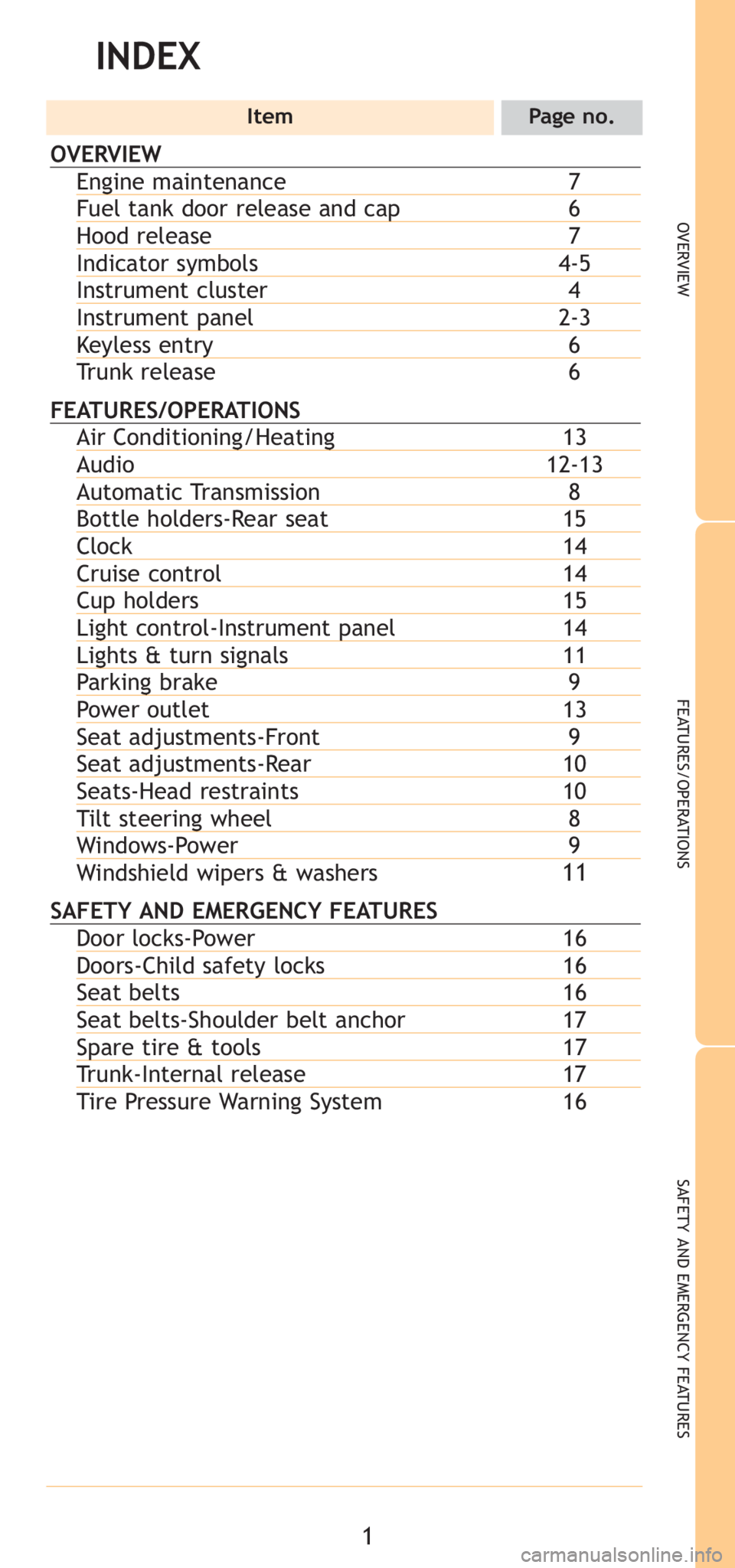
1
OVERVIEW
FEATURES/OPERATIONS
SAFETY AND EMERGENCY FEATURES
INDEX
ItemPage no.
OVERVIEW
Engine maintenance7Fuel tank door release and cap6Hood release 7Indicator symbols4-5Instrument cluster 4Instrument panel2-3Keyless entry 6
Trunk release 6
FEATURES/OPERATIONSAir Conditioning/Heating 13Audio 12-13 Automatic Transmission 8Bottle holders-Rear seat15Clock 14Cruise control14Cup holders15Light control-Instrument panel14Lights & turn signals11Parking brake9Power outlet 13Seat adjustments-Front 9Seat adjustments-Rear10Seats-Head restraints 10Tilt steering wheel8Windows-Power 9
Windshield wipers & washers11
SAFETY AND EMERGENCY FEATURESDoor locks-Power 16Doors-Child safety locks16Seat belts16Seat belts-Shoulder belt anchor17Spare tire & tools17Trunk-Internal release 17
Tire Pressure Warning System 16
Page 18 of 384
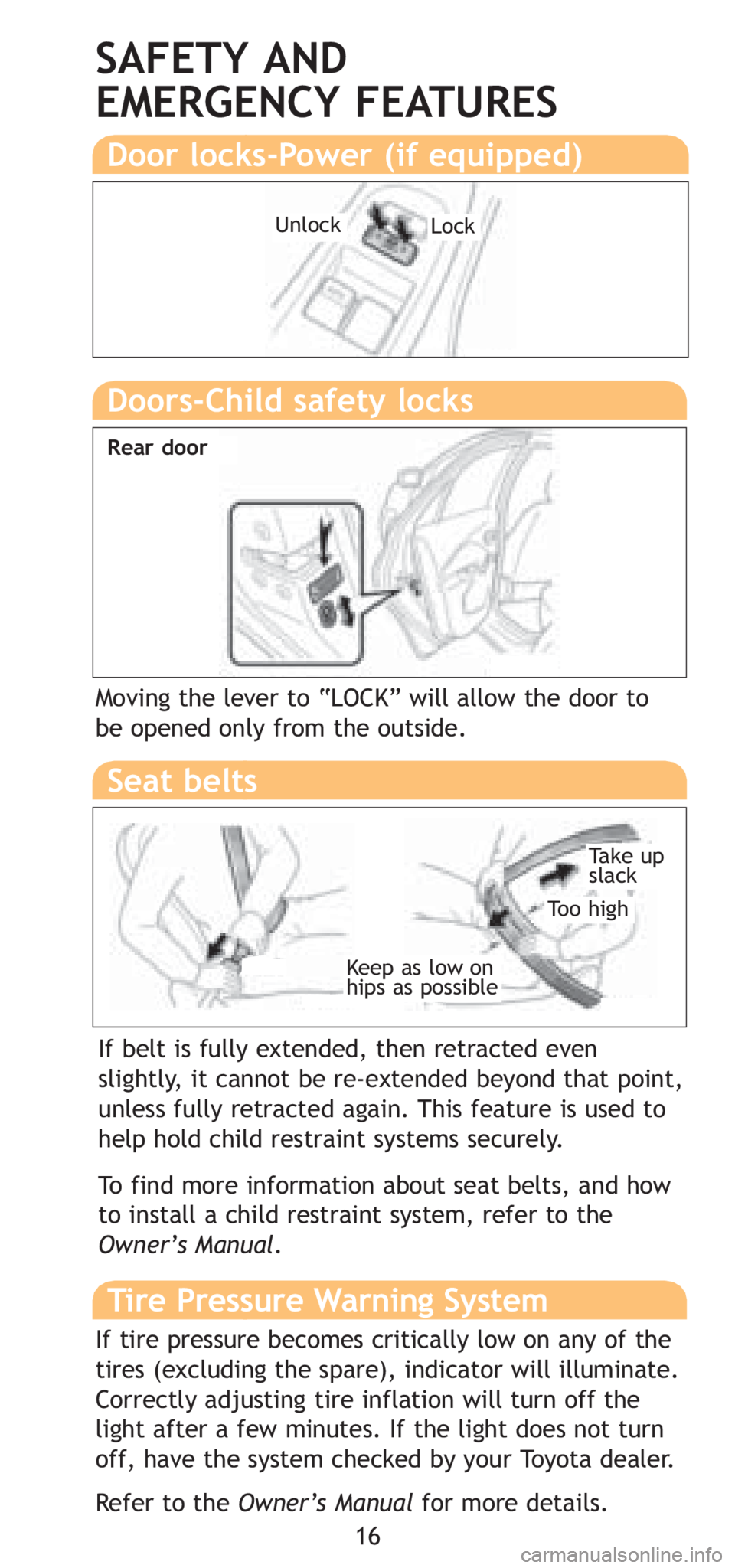
SAFETY AND
EMERGENCY FEATURES
Keep as low on
hips as possible
Take up
slack
Too high
Seat belts
Doors-Child safety locks
Moving the lever to “LOCK” will allow the door to
be opened only from the outside.
If belt is fully extended, then retracted even
slightly, it cannot be re-extended beyond that point,
unless fully retracted again. This feature is used to
help hold child restraint systems securely.
To find more information about seat belts, and how
to install a child restraint system, refer to the
Owner’s Manual.
Rear door
Door locks-Power (if equipped)
UnlockLock
Tire Pressure Warning System
If tire pressure becomes critically low on any of the
tires (excluding the spare), indicator will illuminate.
Correctly adjusting tire inflation will turn off the
light after a few minutes. If the light does not turn
off, have the system checked by your Toyota dealer.
Refer to the Owner’s Manual for more details.
16
Page 47 of 384
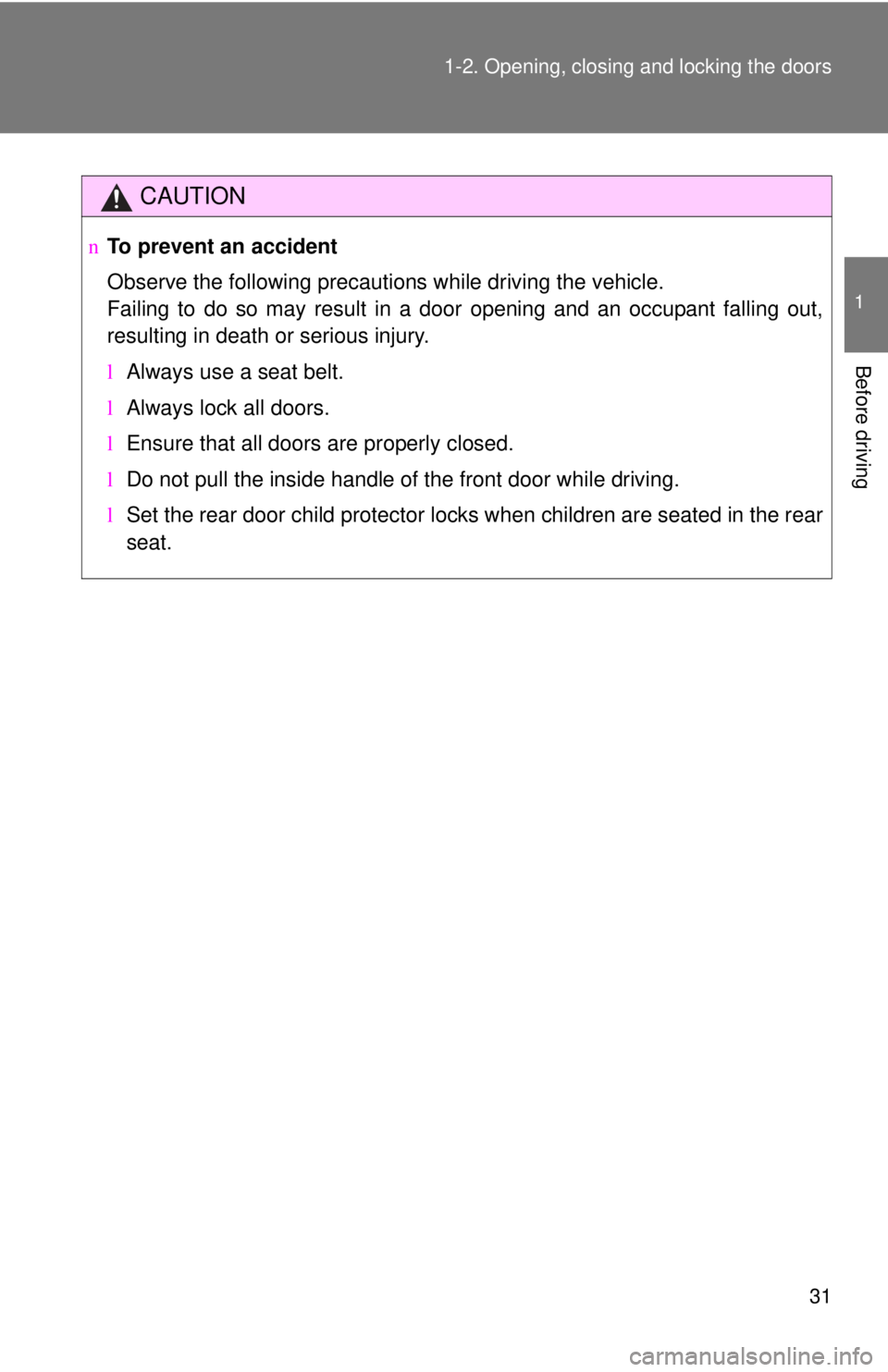
31
1-2. Opening, closing and locking the doors
1
Before driving
CAUTION
n
To prevent an accident
Observe the following precautions while driving the vehicle.
Failing to do so may result in a door opening and an occupant falling out,
resulting in death or serious injury.
lAlways use a seat belt.
l Always lock all doors.
l Ensure that all doors are properly closed.
l Do not pull the inside handle of the front door while driving.
l Set the rear door child protector locks when children are seated in the rear
seat.
Page 60 of 384
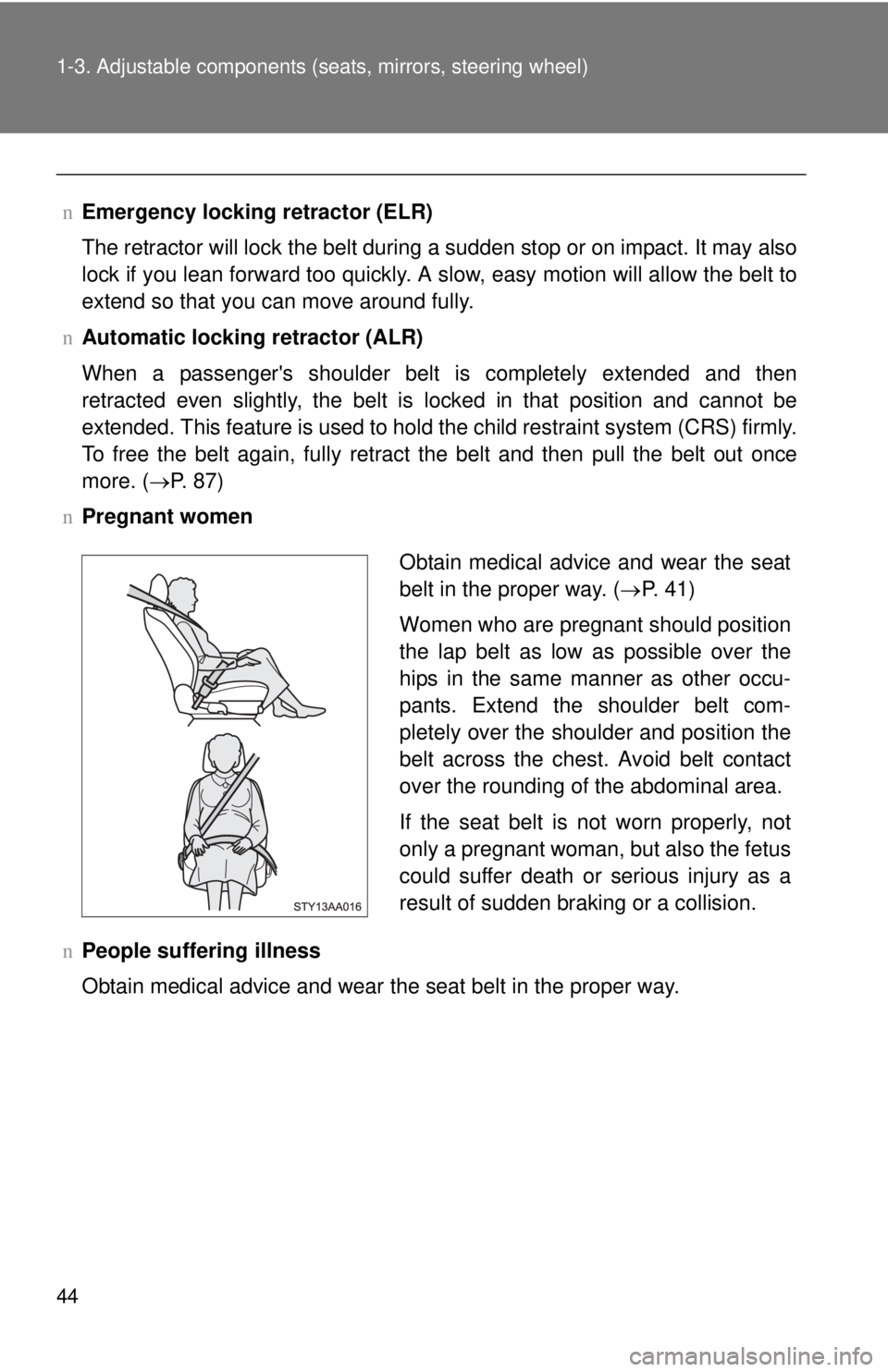
44 1-3. Adjustable components (seats, mirrors, steering wheel)
nEmergency locking retractor (ELR)
The retractor will lock the belt during a sudden stop or on impact. It may also
lock if you lean forward too quickly. A slow, easy motion will allow the belt to
extend so that you can move around fully.
n Automatic locking retractor (ALR)
When a passenger's shoulder belt is completely extended and then
retracted even slightly, the belt is locked in that position and cannot be
extended. This feature is used to hold the child restraint system (CRS) firmly.
To free the belt again, fully retract the belt and then pull the belt out once
more. ( →P. 87)
n Pregnant women
n People suffering illness
Obtain medical advice and wear the seat belt in the proper way.
Obtain medical advice and wear the seat
belt in the proper way. ( →P. 41)
Women who are pregnant should position
the lap belt as low as possible over the
hips in the same manner as other occu-
pants. Extend the shoulder belt com-
pletely over the shoulder and position the
belt across the chest. Avoid belt contact
over the rounding of the abdominal area.
If the seat belt is not worn properly, not
only a pregnant woman, but also the fetus
could suffer death or serious injury as a
result of sudden braking or a collision.
Page 61 of 384
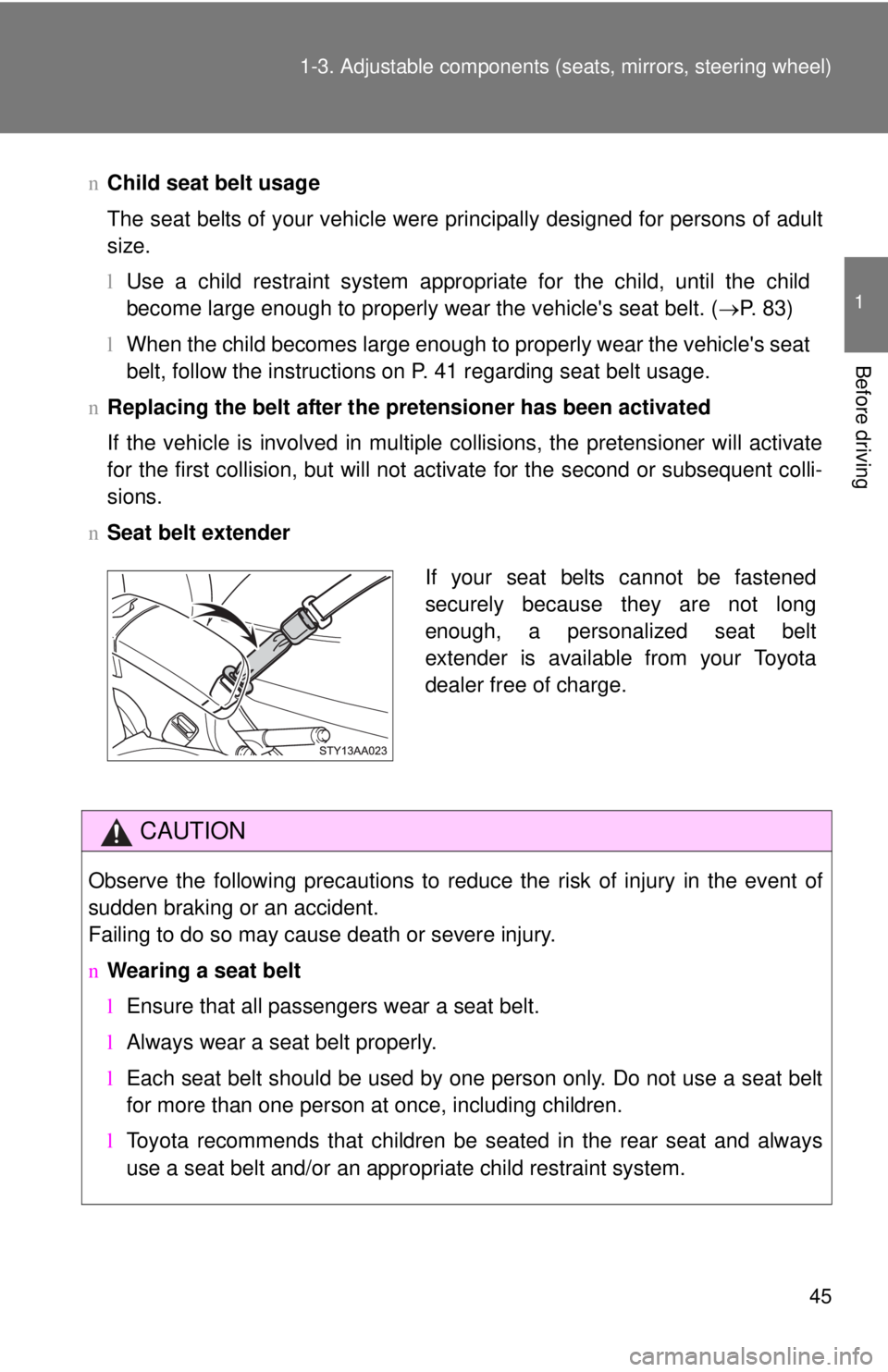
45
1-3. Adjustable components (s
eats, mirrors, steering wheel)
1
Before driving
nChild seat belt usage
The seat belts of your vehicle were principally designed for persons of adult
size.
lUse a child restraint system appropriate for the child, until the child
become large enough to properly wear the vehicle's seat belt. ( →P. 83)
l When the child becomes large enough to properly wear the vehicle's seat
belt, follow the instructions on P. 41 regarding seat belt usage.
n Replacing the belt after the pretensioner has been activated
If the vehicle is involved in multiple collisions, the pretensioner will activate
for the first collision, but will not activate for the second or subsequent colli-
sions.
n Seat belt extender
CAUTION
Observe the following precautions to reduce the risk of injury in the event of
sudden braking or an accident.
Failing to do so may cause death or severe injury.
nWearing a seat belt
lEnsure that all passengers wear a seat belt.
l Always wear a seat belt properly.
l Each seat belt should be used by one person only. Do not use a seat belt
for more than one person at once, including children.
l Toyota recommends that children be seated in the rear seat and always
use a seat belt and/or an appropriate child restraint system.
If your seat belts cannot be fastened
securely because they are not long
enough, a personalized seat belt
extender is available from your Toyota
dealer free of charge.
Page 63 of 384
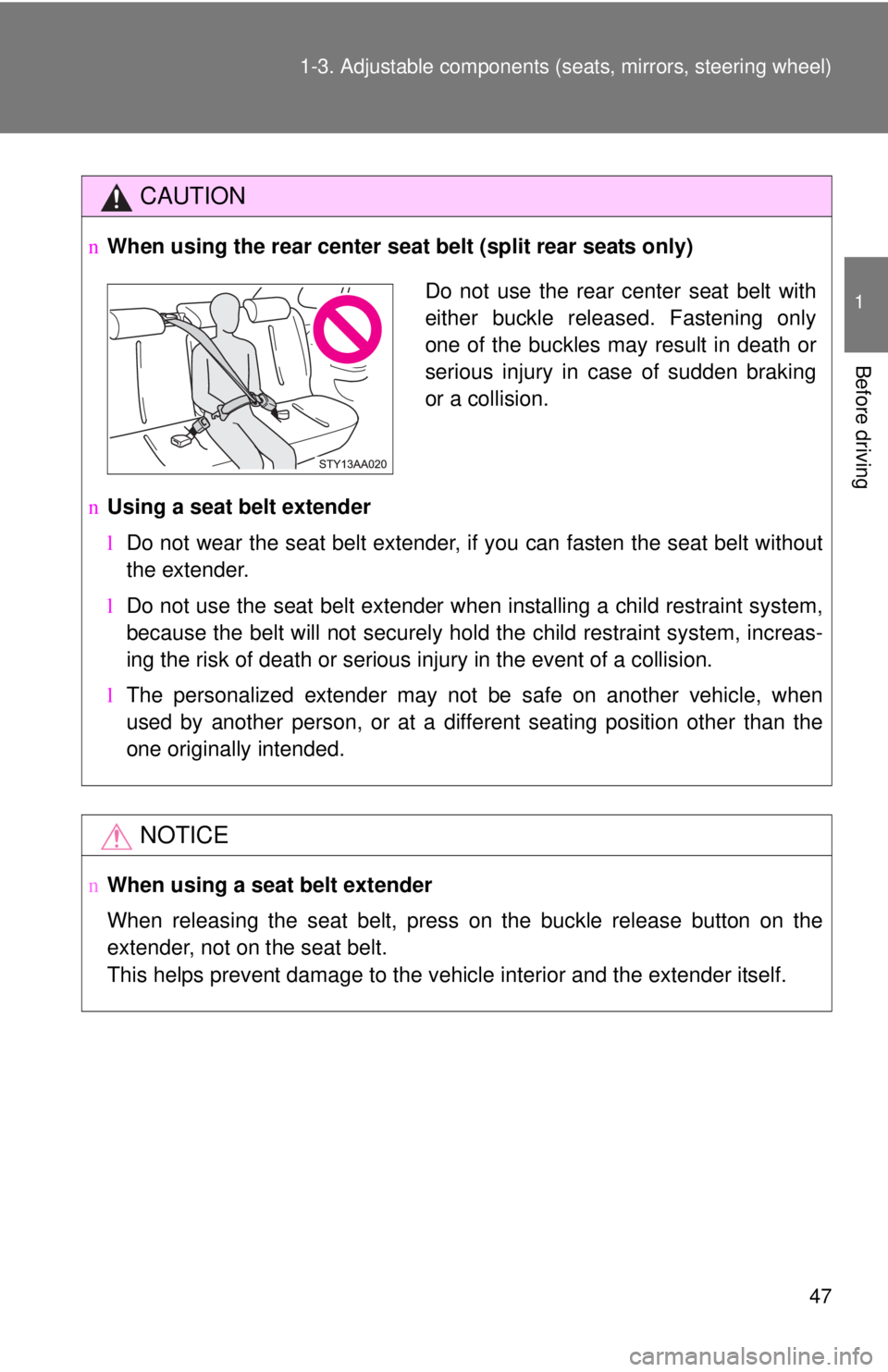
47
1-3. Adjustable components (s
eats, mirrors, steering wheel)
1
Before driving
CAUTION
nWhen using the rear center seat belt (split rear seats only)
n Using a seat belt extender
lDo not wear the seat belt extender, if you can fasten the seat belt without
the extender.
l Do not use the seat belt extender when installing a child restraint system,
because the belt will not securely hold the child restraint system, increas-
ing the risk of death or serious injury in the event of a collision.
l The personalized extender may not be safe on another vehicle, when
used by another person, or at a different seating position other than the
one originally intended.
NOTICE
nWhen using a seat belt extender
When releasing the seat belt, press on the buckle release button on the
extender, not on the seat belt.
This helps prevent damage to the vehicle interior and the extender itself.
Do not use the rear center seat belt with
either buckle released. Fastening only
one of the buckles may result in death or
serious injury in case of sudden braking
or a collision.
Page 90 of 384
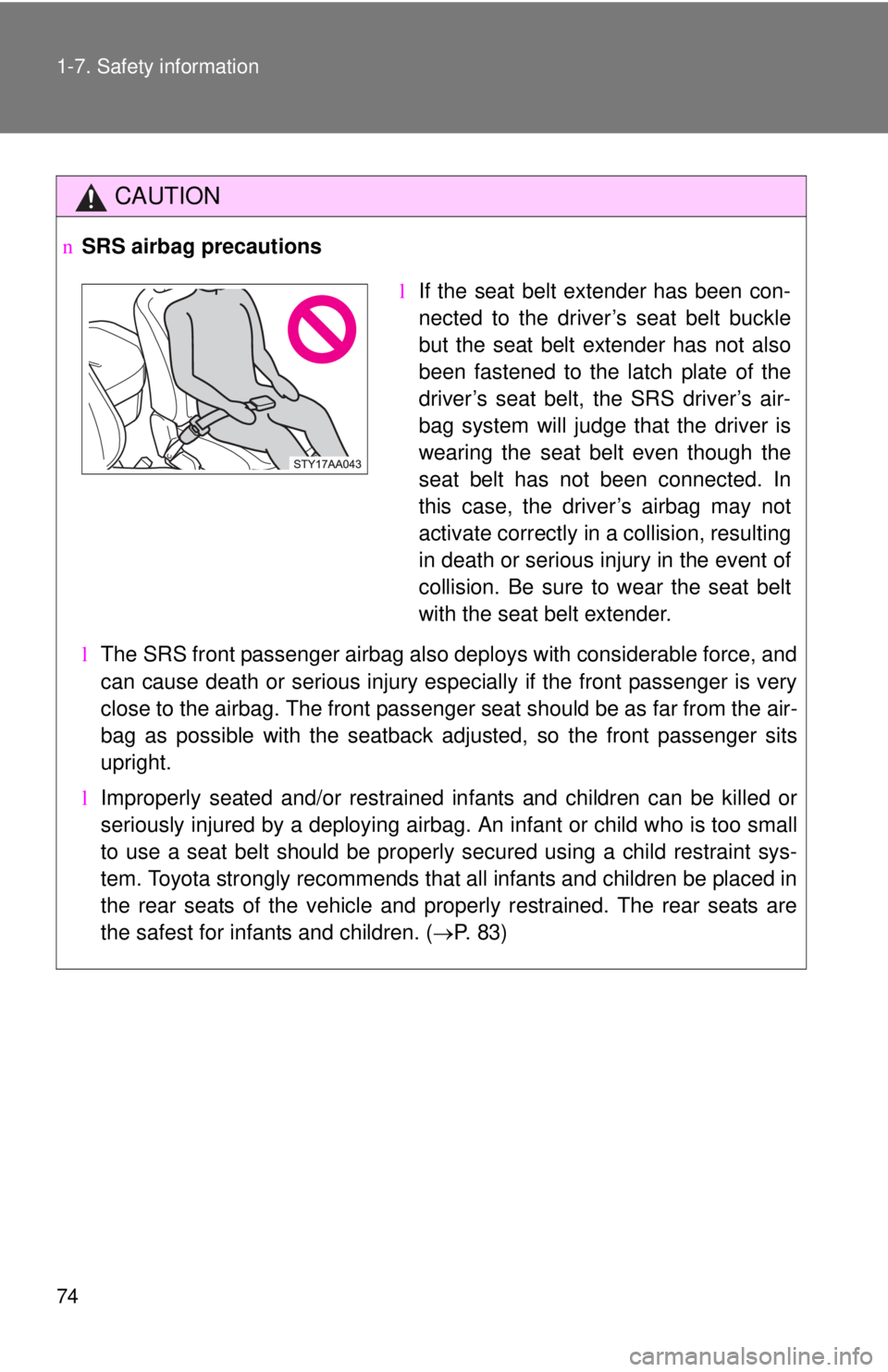
74 1-7. Safety information
CAUTION
nSRS airbag precautions
lThe SRS front passenger airbag also deploys with considerable force, and
can cause death or serious injury especially if the front passenger is very
close to the airbag. The front passenger seat should be as far from the air-
bag as possible with the seatback adjusted, so the front passenger sits
upright.
l Improperly seated and/or restrained in fants and children can be killed or
seriously injured by a deploying airbag. An infant or child who is too small
to use a seat belt should be properly secured using a child restraint sys-
tem. Toyota strongly recommends that all infants and children be placed in
the rear seats of the vehicle and properly restrained. The rear seats are
the safest for infants and children. ( →P. 83)
lIf the seat belt extender has been con-
nected to the driver’s seat belt buckle
but the seat belt extender has not also
been fastened to the latch plate of the
driver’s seat belt, the SRS driver’s air-
bag system will judge that the driver is
wearing the seat belt even though the
seat belt has not been connected. In
this case, the driver’s airbag may not
activate correctly in a collision, resulting
in death or serious injury in the event of
collision. Be sure to wear the seat belt
with the seat belt extender.
Page 91 of 384
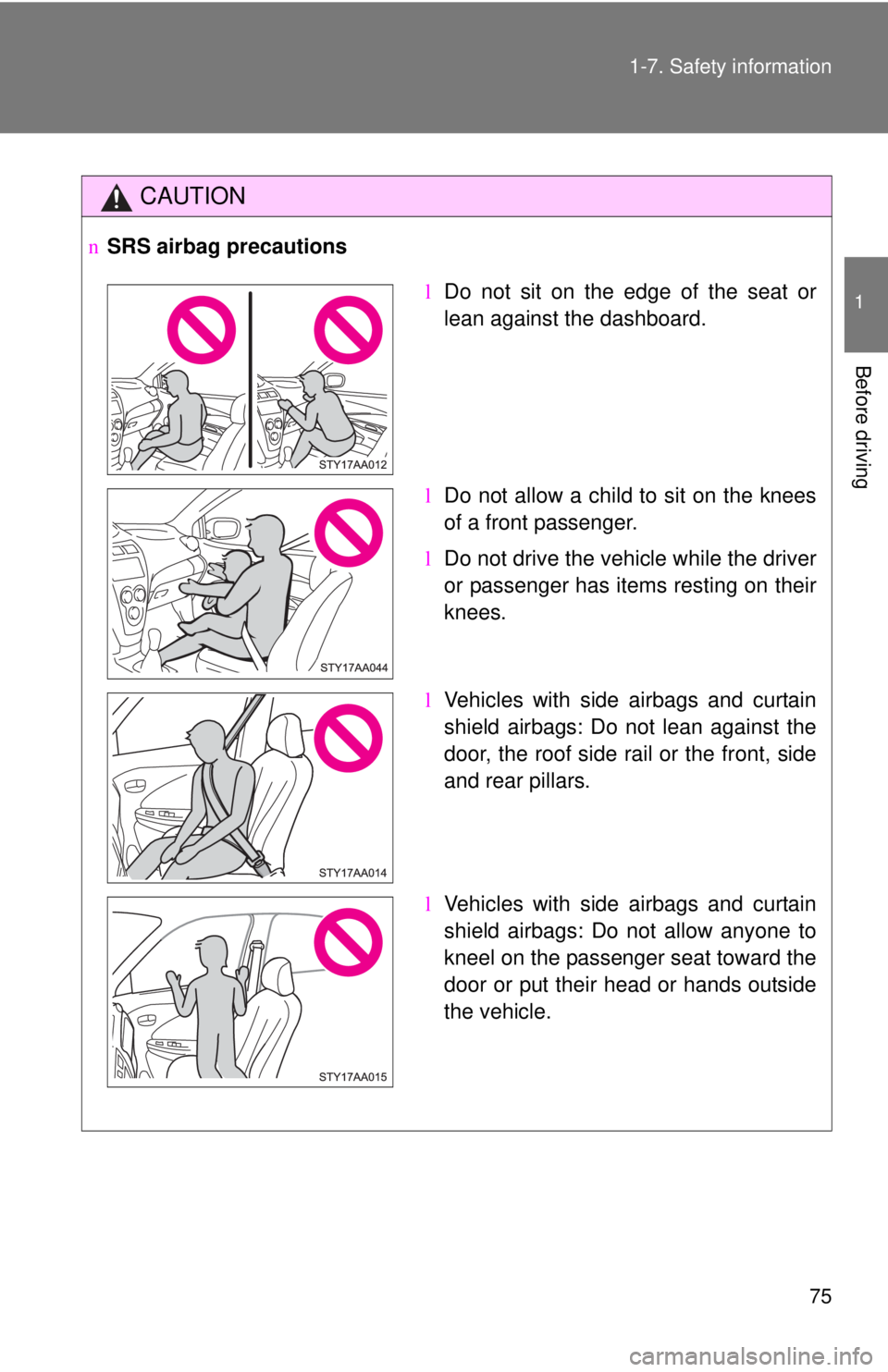
75
1-7. Safety information
1
Before driving
CAUTION
n
SRS airbag precautions
lDo not sit on the edge of the seat or
lean against the dashboard.
l Do not allow a child to sit on the knees
of a front passenger.
l Do not drive the vehicle while the driver
or passenger has items resting on their
knees.
l Vehicles with side airbags and curtain
shield airbags: Do not lean against the
door, the roof side rail or the front, side
and rear pillars.
l Vehicles with side airbags and curtain
shield airbags: Do not allow anyone to
kneel on the passenger seat toward the
door or put their head or hands outside
the vehicle.
Page 95 of 384
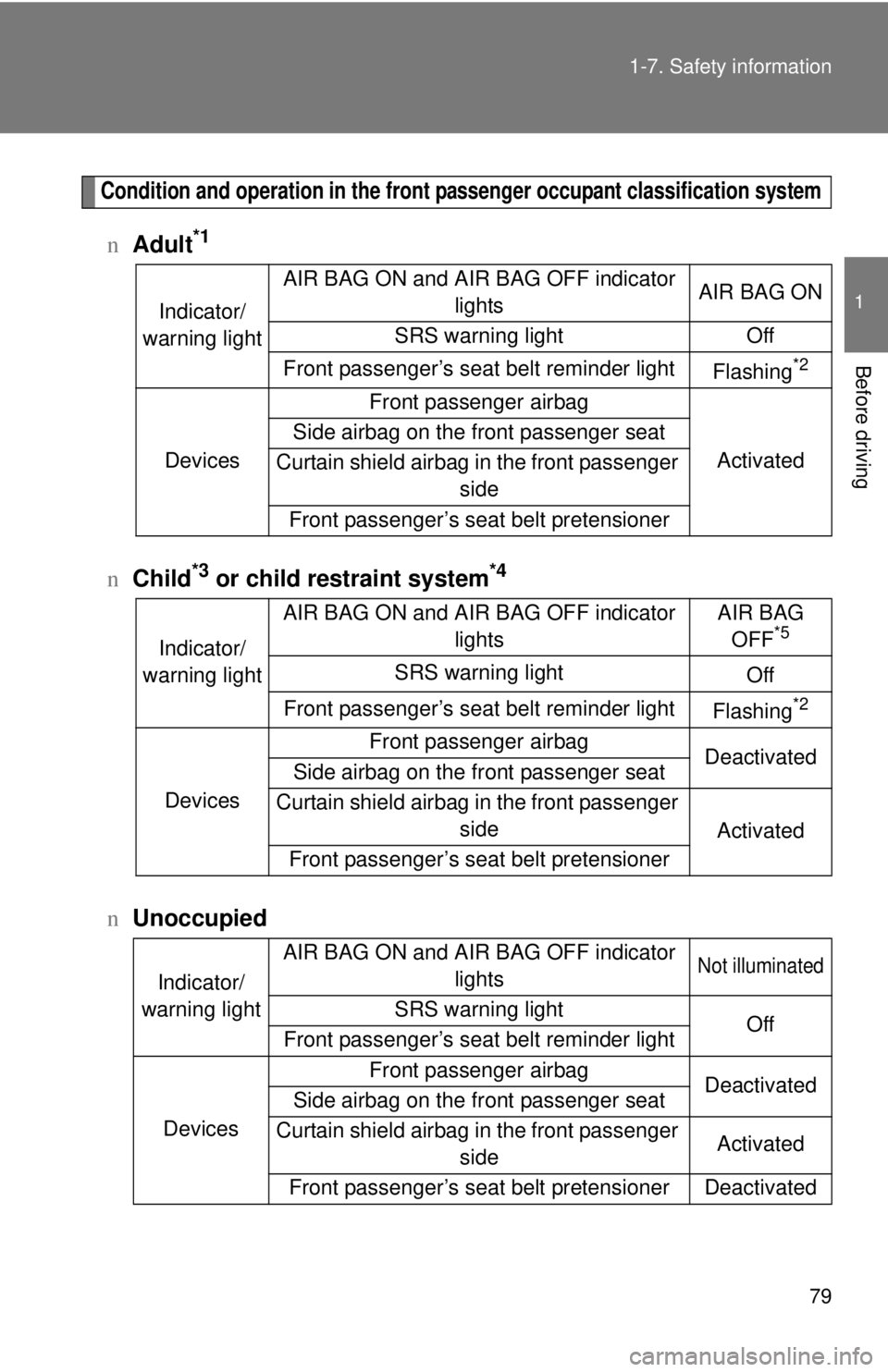
79
1-7. Safety information
1
Before driving
Condition and operation in the front passenger occupant classification system
n
Adult*1
nChild*3 or child restraint system*4
nUnoccupied
Indicator/
warning light AIR BAG ON and AIR BAG OFF indicator
lights AIR BAG ON
SRS warning light Off
Front passenger’s seat belt reminder light Flashing
*2
DevicesFront passenger airbag
Activated
Side airbag on the front passenger seat
Curtain shield airbag in the front passenger side
Front passenger’s seat belt pretensioner
Indicator/
warning light AIR BAG ON and AIR BAG OFF indicator
lights AIR BAG
OFF
*5
SRS warning light Off
Front passenger’s seat belt reminder light Flashing
*2
DevicesFront passenger airbag
Deactivated
Side airbag on the front passenger seat
Curtain shield airbag in the front passenger side Activated
Front passenger’s seat belt pretensioner
Indicator/
warning light AIR BAG ON and AIR BAG OFF indicator
lights
Not illuminated
SRS warning light Off
Front passenger’s seat belt reminder light
Devices Front passenger airbag
Deactivated
Side airbag on the front passenger seat
Curtain shield airbag in the front passenger side Activated
Front passenger’s seat belt pretensioner Deactivated
Page 96 of 384

80 1-7. Safety information
nThere is a malfunction in the system
*1:The system judges a person of adult size as an adult. When a
smaller adult sits in the front pa ssenger seat, the system may rec-
ognize him/her as a child dependi ng on his/her physique and pos-
ture.
*2:In the event the front passenge r does not wear a seat belt.
*3:When a larger child who has outgrown a child restraint system sits
in the front passenger seat, the system may recognize him/her as
an adult depending on his/her physique or posture.
*4:Never install a rear-facing child restraint system on the front pas-
senger seat. A forward-facing child restraint system should only be
installed on the front passenger seat when it is unavoidable. ( →P.
83)
*5:In case the indicator is not illumi nated, consult this manual as for
installing the child restraint system properly. ( →P. 8 7 )
Indicator/
warning light AIR BAG ON and AIR BAG OFF indicator
lights AIR BAG
OFF
SRS warning light On
Front passenger’s seat belt reminder light Off
Devices Front passenger airbag
Deactivated
Side airbag on the front passenger seat
Curtain shield airbag in the front passenger side Activated
Front passenger’s seat belt pretensioner